New week, same story. Average bank rates continue their slow, quicksand-like fall. Average one-year CD Rates dipped from .398% to .395% APY. Three year average CD rates dropped from .785% to .780% APY. Five year average CDs dropped to 1.135% APY from 1.147% while online savings accounts dipped slightly from .742% to .738% APY.
Looking beyond averages, the top rates in some select categories are:
- Savings: Salem Five Direct remained steady at 1.25% APY
- 1 Year CD: CIT Bank at 1.05% APY.
- 3 Year CD: CIT Bank at 1.44% APY
- 5 Year CD: CIT Bank - 1.85% APY. Nationwide Bank, which shared the top spot with CIT, dropped their 5 year CD from 1.85% to 1.75% APY.
- Rewards Checking: Hope Community Credit Union - 3.51% APY rewards rate up to $10,000. To learn about reward checking and Hope Community Credit Union read my rate update from last week.
Local banks and credit unions often offer better rates (especially for CDs) than online banks so be sure to check them out. View local CD rates in your area.
The chart below shows the trend in average rates since October 2012.
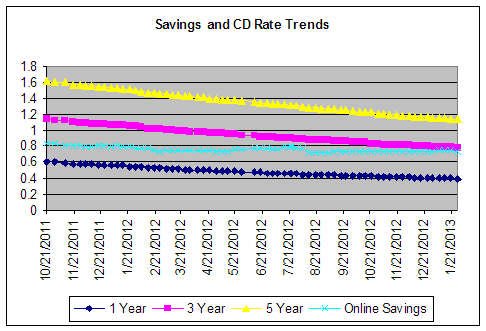
The difference in the rate of decline between online savings and CD rates can be viewed on the chart below, which shows the spread between online savings account rates and 12 month CDs. After hitting a new high several weeks in a a row, the spread dropped a bit to .343 percentage points. On average, online savings account rates pay .343 percentage points more than 1 year CDs, up from .23 percentage points more at the beginning of last year.
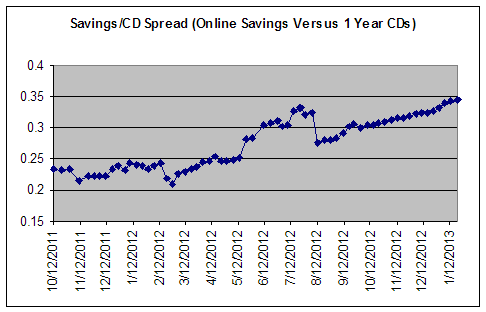
Mortgage Rates
This week I thought I would take a look at mortgage rates. While savers have suffered over the past five years, borrowers have benefited from the rock-bottom rates. How low? The chart below shows what rates have done over the past 40 years (data from Freddie Mac).
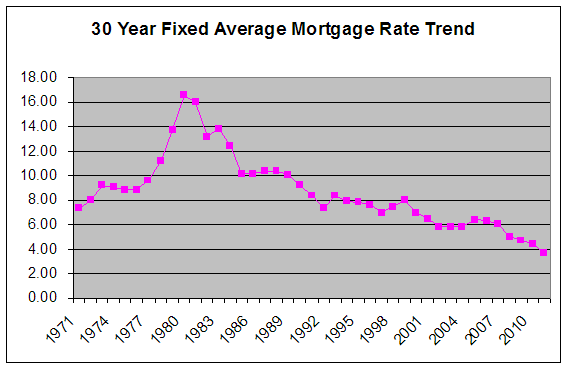
We're talking historical lows. Notice that after the peak in 1980, rates have trended down regardless of recession or boom. The downturn in rates has been a long-term trend. This trend has bottomed out. Rates don't have that much lower to go. So, while the Fed has indeed engineered extremely low rates over the past four years, this trend was already well in place before the financial crisis. Average rates in 2005, before the Fed intervened were 5.87%, extremely low by the standards of the past forty years and one factor in the housing rise and fall in the 2000s.
Will morgage rates go back up? Absolutely. When? It's hard to know but I'd guess around the same time that savings and CD rates begin to rise - in about 12 - 18 months. Mortgage rates are already off their absolute bottom as regulation and fees from Fannie Mae and Freddie Mac drive up lending costs.
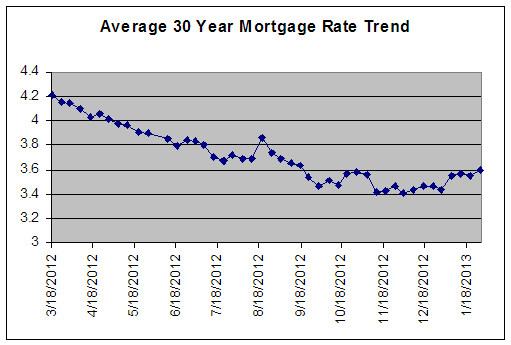
Even when rates go up, I don't expect them to soar. My hypothesis is that the slow growth, low rate environment we are in is a demographic issue tied to the aging of the population and workforce. Caring for the growing percentage of eldely citizens will take an economic toll across the developed and developing world. Until we figure out a better way of caring for the elderly, this burden will be a severe drag on economic growth, keeping rates low.
General rate environment
My forecast remains unchanged. I am forecasting that deposit rates will continue to gradually move lower in 2013. My reasoning includes:
- The Fed has committed to keeping rates exceptionally low as long as unemployment is above 6 1/2 percent. It currently stands at 7.9%. At the current rate of decline, it will take at least 2-3 years to get to 7.9%. If the economy picks up, it could get there sooner.
- The economy has picked up a bit of steam in the last couple of quarters. But GDP growth of 1-2% will not be enough to quickly bring down the unemployment rate. I project steady but moderate economic growth of around 2.5% in 2013.
- Bank are awash in cash from individuals and corporations and do not need more deposit dollars. Third quarter 2012 FDIC data showed banks had over $9 trillion in deposits, up from $8.5 trillion in the third quarter of 2011. Many banks are having trouble figuring out how to deploy their cash. Part of this is because of lending fears and credit quality and the other part is due to increased governmental oversight.
- Demographic trends are unfavorable. Unfortunately, the United States has entered a demographic slide. As the large baby boom generation ages and retires, this puts a large strain on the country's productivity and spending. I believe that demographics is a general driver of economic development. A young population lifts all boats. An aging will leave quite a few boats stranded and make it difficult for the others. Japan and Europe have even worse demographic problems and their economies reflect that. As China's population ages, look for its growth to ebb. This demographic slide will be a factor for the next ten to twenty years, not stopping growth, but certainly acting as a headwind.
- Government grid-lock over the debt ceiling and sequestration. Gridlock continues and although unlikely the U.S. could begin to default on its obligations if the debt ceiling is not raised. Either way, the partisan bickering does little to establish confidence.
Potential positive Black Swans (unforseen events that could skew the forecast). Read my article from several weeks ago on Black Swans and how they impact forecasts.
Negative:
- A major natural disaster, pandemic, or terrorist attack.
- A major bank collapse in Europe, China, or Japan.
- War in the Middle East (not exactly unforseen)
- A major political change that causes conflict or threatens established institutions
Positive:
- A technology break-through related to energy, medicine, communications, transportation, or some other field.
- General lifting of pessimism.
If you have any more Black Swans, post them below. I'm an optimist so I'd like to think that progress and achievement will win out. It's why I'm banking on rates going up in the next 12-18 months. Minus any major black swans, here is my savings rate forecast for 2013.
My outlook: Savings rates will continue to drift lower for the next 12-18 months before beginning to move higher. How high and how fast they move will depend on the government's ability to stop bickering and resolve their budget and borrowing disputes, the continuation of a recent economic uptick, technological advances, and the ability of Europe to put its woes behind it and resolve its fiscal problems.
Check in every week for a discussion of these factors are changing and how they impact my rate forecast. Feel free to comment with your thoughts below and add any potential Black Swans that may change the course of the economy and rates.
Savings Accounts or CDs?
The data shows that opening a savings account is a better bet than a 1-3 year term CD and I expect this to hold through 2013. Many online banks have raised their savings rates over the past six months while CD rates continue to fall.
So for now, here are my recommendations:
For money you want to keep liquid, go with online savings accounts. They offer better rates than 1-3 year CDs and have shown good rate stability over the past year.
For longer-term money, look to open 4-5 year CDs at local community banks. BestCashCow research has shown that community banks and credit unions offer the most competitive rates on longer-maturity CDs.
I believe this is the best and easiest strategy for keeping your cash liquid and maximizing your savings over the next year.
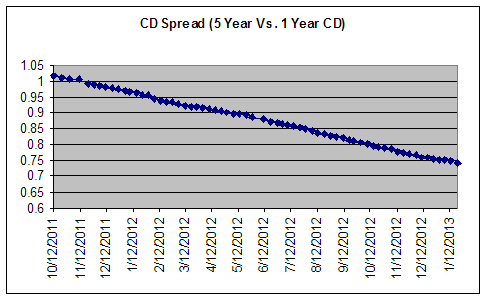
Make the best of a tough savings situation in 2013
Yields may be low in 2013 but a savvy saver can boost the return with no increase in rate by rate shopping. By shopping around, a saver can earn an extra half to full percentage point. On $100,000, that's $1,000 in extra cash per year. Remember, even in today's environment, there is competition for your cash.
As always, I welcome your thoughts and comments.













Comments
Sol
January 29, 2013
Two conflicting pieces of economic data.
1. Housing prices rise by most in six year according to the S&P/Case-Shiller index.
2. Consumer confidence as measured by the Conference Board dropped from 66.7 to 58.6.
Strange that housing prices rising and consumer confidence falling.
Is this review helpful? Yes:1 / No: 0
Sol
January 30, 2013
Unexpected news. The U.S. economy shrank last quarter because of cuts in defense spending.
http://www.bloomberg.com/news/2013-01-30/economy-in-u-s-unexpectedly-shrinks-as-defense-spending-plunges.html
Is this review helpful? Yes:1 / No: 0
Sol
February 01, 2013
Jobless rate rose to 7.9% from 7.8%. Need to get to 6.5% before the Fed will raise rates and going in the wrong direction.
http://www.bloomberg.com/news/2013-02-01/payrolls-in-u-s-rose-in-january-after-jumping-at-end-of-2012.html
Is this review helpful? Yes:0 / No: 0
Add your Comment
use your Google account
or use your BestCashCow account